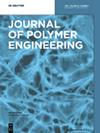PNIPAAM/SA pH-responsive microcapsules based on chemical and non-covalent crosslinking
IF 1.7
4区 工程技术
Q4 POLYMER SCIENCE
引用次数: 1
Abstract
Abstract A triple interpenetrating polymer network (IPN) with dual responses to temperature and pH was constructed based on chemical crosslinking and electrostatic interaction. In this IPN, CaCO3 microspheres were used as the kernel and PNIPAAM/sodium alginate microcapsules were prepared by the inverse emulsion polymerization method. Research results demonstrated that CaCO3 kernels were decomposed into Ca2+ and CO2 at pH 1.2. Such decomposition facilitated the formation of triple IPN of Ca2+ crosslinking. Moreover, microcapsules were expanded by tension of CO2 and the volume increased to 3.55 × 105 times that of the original microcapsules, with capsules remaining an intact morphology. These microcapsules loading doxorubicin hydrochloride (DOX) stability and responses to environment were investigated. No drug overflow was observed at pH 7.4, indicating the high stability of microcapsules. However, DOX was released gradually in the simulated human stomach acid with a weak solution of hydrochloric acid (pH 1.2, 37 °C). This showed that the prepared microcapsules were feasible for drug-loaded capsules and the controlled drug release behavior could relieve side effects of drugs to human body. Moreover, it will help to increase the drug utilization and realize accurate treatment.基于化学和非共价交联的PNIPAAM/SA ph响应微胶囊
摘要基于化学交联和静电相互作用,构建了温度和pH双响应的三互穿聚合物网络(IPN)。该IPN以CaCO3微球为内核,采用乳液反聚法制备PNIPAAM/海藻酸钠微胶囊。研究结果表明,在pH为1.2的条件下,CaCO3核分解为Ca2+和CO2。这种分解促进了Ca2+交联的三重IPN的形成。在CO2张力作用下,微胶囊的体积增加到原微胶囊的3.55 × 105倍,微胶囊的形态保持完整。考察了微胶囊载药盐酸阿霉素的稳定性和对环境的响应。pH为7.4时未出现药物溢出现象,说明微胶囊稳定性高。然而,DOX在盐酸弱溶液(pH 1.2, 37°C)的模拟人胃酸中逐渐释放。说明所制备的微胶囊作为载药胶囊是可行的,其药物释放行为可控,可减轻药物对人体的副作用。此外,还有助于提高药物利用率,实现精准治疗。
本文章由计算机程序翻译,如有差异,请以英文原文为准。
求助全文
约1分钟内获得全文
求助全文
来源期刊

Journal of Polymer Engineering
工程技术-高分子科学
CiteScore
3.20
自引率
5.00%
发文量
95
审稿时长
2.5 months
期刊介绍:
Journal of Polymer Engineering publishes reviews, original basic and applied research contributions as well as recent technological developments in polymer engineering. Polymer engineering is a strongly interdisciplinary field and papers published by the journal may span areas such as polymer physics, polymer processing and engineering of polymer-based materials and their applications. The editors and the publisher are committed to high quality standards and rapid handling of the peer review and publication processes.
 求助内容:
求助内容: 应助结果提醒方式:
应助结果提醒方式:


